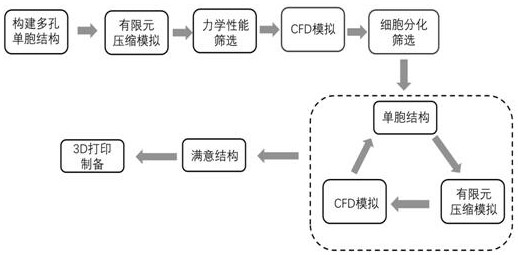Bone repairstentfor directionally inducing bone tissue differentiation
A technology of directional induction and bone repair, applied in the field of biomedical engineering, can solve problems such as ignoring the influence of bone cells, and achieve the effects of directional bone tissue differentiation, enhancement of osteogenic performance, and promotion of directional induction and differentiation
- Summary
- Abstract
- Description
- Claims
- Application Information
AI Technical Summary
Problems solved by technology
Method used
Image
Examples
Embodiment
[0043] A bone repair scaffold for directional induction of bone tissue differentiation, specifically comprising the following steps:
[0044] 1. Structural Design of Bone Repair Scaffold
[0045] The bone repair scaffold is designed on the basis of the unit cell structure. The characteristics of the unit cell determine the characteristics of the overall scaffold. It can be arranged in various shapes, which is convenient and quick to meet the precise repair of bone defects.
[0046] The scaffold unit cell is based on a cube with a side length of 500 microns, and its structure is designed. The unit cell size of 500 microns enables high-precision repair of bone defects.
[0047] In order to meet the mechanical properties and pore size requirements, three different unit cell structures were preliminarily designed, and each structure corresponds to three different pore sizes.
[0048] Structure 1 is a cylindrical unit cell structure, and the diameters of the circular holes are 200 ...
PUM
| Property | Measurement | Unit |
|---|---|---|
| size | aaaaa | aaaaa |
Abstract
Description
Claims
Application Information
 Login to View More
Login to View More - R&D
- Intellectual Property
- Life Sciences
- Materials
- Tech Scout
- Unparalleled Data Quality
- Higher Quality Content
- 60% Fewer Hallucinations
Browse by: Latest US Patents, China's latest patents, Technical Efficacy Thesaurus, Application Domain, Technology Topic, Popular Technical Reports.
© 2025 PatSnap. All rights reserved.Legal|Privacy policy|Modern Slavery Act Transparency Statement|Sitemap|About US| Contact US: help@patsnap.com



